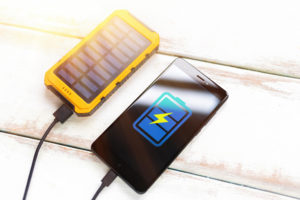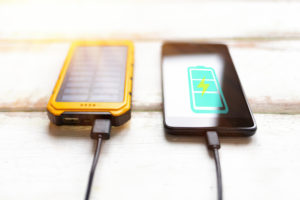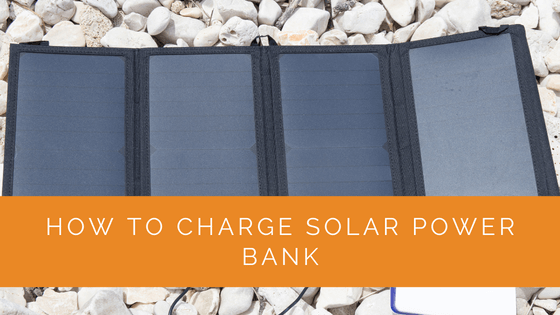Are you a social media addict going on a long hike and worried about not finding charging ports in the middle of the forest? You can now chill because solar power banks have got you covered.
You might think that a regular power bank can help, too, but what’s unique about a solar power bank?
A power bank requires charging, and finding charging ports can be inconvenient. Solar power banks solve this problem by harnessing energy from the sun.
One thing that’s abundant throughout the day is sunlight unless you live in Antarctica and its winters. Why not utilise this resource to its maximum capacity and post more stories on Instagram without the stress of running out of power?
Read on to learn more about solar power banks and how to use and maintain them.
Contents
- 1 Key Takeaways
- 2 What is a Solar Power Bank?
- 3 Why Should You Use a Solar Power Bank?
- 4 How Long Does It Take to Charge a Solar Power Bank?
- 5 How Long Does it Take to Charge Your Gadget?
- 6 How to Use a Solar Power Bank?
- 7 What is the Science Behind Solar Chargers?
- 8 Are Solar Power Banks the Right Fit for You?
- 9 Case Study: Using a Solar Power Bank for Off-Grid Adventures
- 10 Expert Insights From Our Solar Panel Installers About Charging a Solar Power Bank
- 11 Our Expertise in Solar Products
- 12 To Sum Up
Key Takeaways
- Solar power banks are valuable for outdoor enthusiasts as they can charge themselves using sunlight, providing a reliable power source for mobile devices.
- The time it takes to charge a solar power bank depends on the number of solar panels it has, and they can be used to charge smartphones multiple times.
- Using a solar power bank is a straightforward two-step process: charge the power bank’s battery with sunlight and then use it to charge your gadgets. However, these chargers have advantages like portability and disadvantages like reduced effectiveness during rainy or cloudy days.
What is a Solar Power Bank?
A solar power bank is a valuable technology that uses sunlight or a wall outlet and can further charge your gadgets. They usually have USB ports to charge your mobile devices and laptops using a USB cable.
Solar power banks are comparatively more reliable and functional. Some feature a single photovoltaic cell integrated into the case, while others have several solar cells that can be folded.
Portable solar charging power banks are available in multiple configurations and solar ratings. The size of the battery varies as well. They are DC power supply systems that almost always use high-efficiency lithium-ion batteries.
Why Should You Use a Solar Power Bank?
Solar power banks are a good investment for many reasons. They are reliable, well-functional, easy to carry. The following are more benefits of this unique power bank with wireless charging.
- Great Battery Backup
- Portability
- Foldable design
- Wireless charging options
- Compatibility with all devices
- Multiple USB charging ports

How Long Does It Take to Charge a Solar Power Bank?
It’s time to understand how long it takes to charge a solar power bank. This typically depends on the count of solar panels that a power bank has. The photovoltaic effect converts more sunlight into electricity. Therefore, the more panels you have, the sooner it will charge.
On average, a solar power bank with 25,000 mAh can be charged by the sun alone for 25-50 hours. This assumes that the weather circumstances were ideal, i.e. there is enough sunlight with no obstructions.
How Long Does it Take to Charge Your Gadget?
Most solar power banks have a battery capacity between 8000 mAH to 14000 mAH. With varied battery capacity, charging a modern smartphone battery 3 to 5 times a day is enough.
The golden rule is dividing the solar power bank’s battery capacity by the phone’s capacity. This will estimate how often you can charge your phone with the power bank. For example, if your power bank has a 12,000 mAh battery and your phone has a 4,000 mAh battery, three complete charges = 12,000 / 4,000.
How to Use a Solar Power Bank?
Reading the user manual answers this question, but if not, here are the basics to help you.
As the name suggests, a solar charger power bank is used to charge gadgets using solar power. However, the power bank technically charges its battery energy before discharging it to your laptop, tablet or phone. These devices should be called “solar dischargers cum chargers” for this reason.
Although the name isn’t particularly appealing, it accurately depicts how simple and easy it is to use an HG solar power bank. The method of using a solar power bank can be split into two basic steps:
- Charge the battery of the solar panel.
- Discharge it by transferring the power to your gadgets.
Yes, it’s genuinely that simple. Some call it magical, while others refer to it as scientific. The technology behind a portable, compact solar charger is relatively easy to crack.
What is the Science Behind Solar Chargers?
The solar panels are connected to charge controllers, which use charging circuitry to charge the battery. The power bank uses LED lights to show the existing battery capacity.
The AN Adapter can charge the power bank using AC power if necessary.
The battery pack is powered by the induction coil on the top side of the power bank. When a mobile phone is placed on top of a power bank, electromagnetic induction causes an electric current to flow through the coil in the phone’s backside. This is used to charge the phone wirelessly.

Are Solar Power Banks the Right Fit for You?
There are a variety of factors you should consider before buying solar chargers. Read on to know each one in detail by understanding its advantages and disadvantages.
Advantages of a Solar Power Bank
- The solar-powered charger has the advantage of being portable. These chargers are light enough to carry in pockets or backpacks without worrying about weight.
- Another significant benefit is that solar chargers can be used almost anywhere without connecting the charger or device to an electrical outlet.
- Solar power banks contain an AC outlet that can power other electronic devices such as laptops, headphones, tablets, rechargeable lights, and more and mobile phones.
- While the user is on the go, this charger’s panels are usually exposed to sunlight. The batteries will be charged for the duration the charger is exposed to direct sunlight.
Disadvantages of a Solar Power Bank
- As one might imagine, solar phone chargers are less effective during winter due to the lack of sunlight, which might last for some days and prevent the panels from charging the rechargeable battery.
- Most solar power banks cannot be powered during rainy days.
- The charging capacity is determined by the size of the charger’s panel. Getting a smaller and less expensive panel will cause the phones to charge slower than chargers with greater capacity. These will finish the mission considerably more quickly.
- Solar portable power banks might be more costly than a regular charger at the local shops. If someone is having financial difficulties, money may be a stumbling block.
Case Study: Using a Solar Power Bank for Off-Grid Adventures
Background
Outdoor enthusiasts often find themselves in remote locations where access to traditional power sources is limited. The need for a reliable way to keep devices charged, such as smartphones, cameras, and GPS units, becomes crucial for safety and connectivity.
Project Overview
The goal was to provide a solution that could sustain various electronic devices during extended outdoor trips. The chosen solution had to be portable, durable, and capable of generating sufficient power through solar energy.
Implementation
- Selection of Solar Power Bank: A high-capacity solar power bank with a 25,000 mAh battery was selected, featuring multiple USB ports for charging several devices simultaneously. The model was chosen for its durability and ability to withstand outdoor conditions.
- Understanding Device Requirements: The power bank needed to support a smartphone (4,000 mAh battery), a camera (1,500 mAh battery), and a GPS device (2,000 mAh battery). This setup allowed the solar power bank to charge the smartphone approximately six times, the camera sixteen times, and the GPS device twelve times, covering the energy needs for an extended trip.
- Usage Guidance: To maximise the efficiency of the solar power bank, several guidelines were provided:
- Maximise Sunlight Exposure: The power bank should be placed in direct sunlight whenever possible to optimise charging.
- Charge During Peak Sunlight Hours: Peak hours, typically from 10 AM to 4 PM, were identified as the best time for charging.
- Keep Panels Clean: Regular cleaning of the solar panels was recommended to maintain optimal performance.
Results
The solar power bank performed exceptionally well, providing reliable power throughout the trips. It proved sufficient to keep all necessary devices charged, ensuring continuous connectivity and the ability to document the journey. The ease of use and portability made the solar power bank an essential part of the outdoor gear.
Summary
The use of a solar power bank is an effective solution for off-grid energy needs. By selecting a power bank with adequate capacity and following proper usage practices, users can maintain their devices charged even in remote areas. At Solar Panels Network, we offer a range of solar products tailored to meet various needs, helping users stay powered up and connected on their adventures.
Solar power banks are not only convenient but essential for those venturing into areas without reliable power sources. They offer a sustainable and practical way to keep devices operational, making them a valuable addition to any travel kit.
Expert Insights From Our Solar Panel Installers About Charging a Solar Power Bank
Charging a solar power bank is a practical solution for those who love the outdoors and need a reliable power source. The key is to ensure the solar panels receive adequate sunlight, as this directly impacts the charging efficiency.
Senior Solar Technician
Understanding the capacity of your solar power bank and the devices you intend to charge is crucial. This knowledge helps manage expectations and ensures you’re not left without power during critical moments.
Renewable Energy Specialist
While solar power banks are great for off-grid situations, it’s important to remember that they perform best under direct sunlight. Keeping the panels clean and free from obstructions maximises their efficiency.
Solar Product Consultant
Our Expertise in Solar Products
At Solar Panels Network, we are dedicated to offering you valuable insights and assistance regarding solar products. With our deep-rooted knowledge and expertise in the solar product sector, our specialists are ready to guide you in discovering the ideal solar product for your requirements. Whether you aim to enhance your outdoor areas, save energy, or embrace a greener lifestyle, we are well-prepared to provide support. Don’t hesitate to contact us with any questions or inquiries.
To Sum Up
While a variety of power banks are available in the market, a solar power bank is strongly recommended. It keeps the healthier environment spree alive. The world needs more humans who shop ‘sustainably’.
Ensure you carry a fully charged power bank to avoid risks on your long journey. If it’s not sunny, you always have a backup power source, i.e., electricity. So, solar charging is more like an add-on feature.
If you’re going for a long trip, ensure that your charger has many panels to have a good charging capacity to charge devices further. Make the right choice and purchase the one you feel is a good fit for you.
About the Author
Solar Panels Network stands at the forefront of solar energy solutions, driven by a team of seasoned solar engineers and energy consultants. With over decades of experience in delivering high-quality solar installations and maintenance, we are committed to promoting sustainable energy through customer-centric, tailored solutions. Our articles reflect this commitment, crafted collaboratively by experts to provide accurate, up-to-date insights into solar technology, ensuring our readers are well-informed and empowered in their solar energy decisions.

